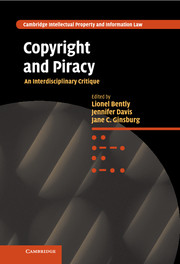Book contents
- Frontmatter
- Contents
- Notes on the contributors
- Editors' preface
- Table of cases
- Table of statutes
- Part I Introduction
- Part II History
- Part III Comparative Law
- Part IV Economics
- Part V Linguistics
- Part VI Computer software
- 10 Copyright, piracy and software
- 11 Of plots, puddings and draught-excluders: the law as it applies to the infringement of computer programs
- Part VII Information studies
- Part VIII Literature
- Part IX Art
- Part X Sociology/music
- Part XI Criminology
- Bibliography
- Index
11 - Of plots, puddings and draught-excluders: the law as it applies to the infringement of computer programs
from Part VI - Computer software
Published online by Cambridge University Press: 17 November 2010
- Frontmatter
- Contents
- Notes on the contributors
- Editors' preface
- Table of cases
- Table of statutes
- Part I Introduction
- Part II History
- Part III Comparative Law
- Part IV Economics
- Part V Linguistics
- Part VI Computer software
- 10 Copyright, piracy and software
- 11 Of plots, puddings and draught-excluders: the law as it applies to the infringement of computer programs
- Part VII Information studies
- Part VIII Literature
- Part IX Art
- Part X Sociology/music
- Part XI Criminology
- Bibliography
- Index
Summary
In his contribution to this volume (Chapter 10), Jon Crowcroft raises a number of concerns, widely shared among those who create software, regarding the legal protection afforded to computer programs. Most notably, there is broad apprehension that the protection afforded to computer programs (or software) under the law of copyright is deficient, for at least two key reasons. First, it fails adequately to protect the creative effort which is embodied in software from those who would seek to exploit it. Second, it signally fails to prevent the ‘piracy’ of software. These two concerns, although both relate to perceived free-riding on the creative effort of the software programmer, are not the same. In the first instance, it is argued by Crowcroft and others, that software is unlike other works protected by copyright and that the law does not protect those aspects of software which entail the most creative effort. As a result, such effort may be unjustly but nonetheless legally appropriated. Second, there is a general perception that for a number of reasons, it is far easier illegitimately to copy and distribute software than it is other sorts of copyright works. This chapter looks at each of these concerns and goes on to ask whether, as Crowcroft and others have advocated, software deserves new sui generis legal protection apart from that afforded to it under the law of copyright.
- Type
- Chapter
- Information
- Copyright and PiracyAn Interdisciplinary Critique, pp. 230 - 244Publisher: Cambridge University PressPrint publication year: 2010



